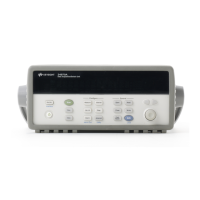In addition to the +5 Volt power supply (Vcc) and ground, the module
controller uses four lines for control and communication:
• RESET, from the Earth Referenced Logic A1U305. RESET is
common to all three slots. The module controller performs a reset
when this line goes high. Reset conditions vary for each plug-in.
• SRQ, to the Earth Referenced Logic A1U305. The SRQ line is a
wired-OR line that can be driven by any plug-in. Consequently,
any module that asserts SRQ (line low), asserts this line in all
other slots and at the Earth Reference Logic.
• DATA IN, from the Floating Logic A1U205 via the opto isolator
A1U312. This line is connected in common to all three slots.
• DATA OUT, from the module controller to the Floating Logic
A1U205 via the opto isolator A1U213. This line is a wired-OR line
that can be driven by any module.
The DATA IN and DATA OUT lines are optically isolated from the
floating logic controller. These lines communicate with the Floating
Logic using an asynchronous serial bit stream.
The serial communications use an 11 bit protocol; a start bit, 8 data
bits, an attention bit, and a stop bit. The attention bit is 1 if the 8
data bits are an address/command, or 0 if the 8 data bits modify or
provide data for the previously sent command.
The module controller uses the hardwired slot-ID bits to decode the
serial bit stream address. When the address/command message
address matches the slot-ID, the plug-in is selected and responds to
the following commands. All other plug-ins will ignore the commands
until a new address/command message is received.
A 12 MHz crystal, Y101, is the clock for the module controller.
The module ID is a four bit pattern set through RP102. The Ferro-
electric RAM U102 provides data storage of the calibration constants
for the analog output channels. Data in and out of U102 is serial.
8 data lines, connected to U101 port 1, are used by the digital input
and output ports. One of the data lines is used to send serial data to
the analog output channels. The totalizer edge count is controlled by
U101 P0.6 and read at U101 P3.4.
U101 enters a low-power idle mode when inactive. U101 responds when
a command is received or when a scheduled alarm scan is needed.
Chapter 5 Theory of Operation
Multifunction Module
152

